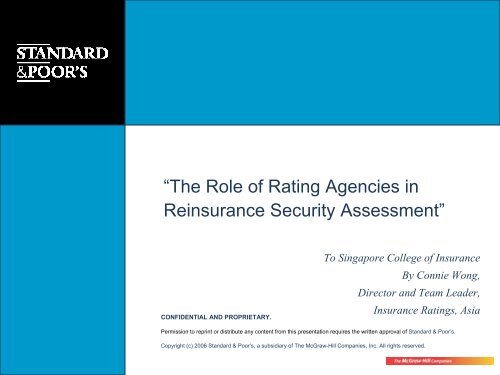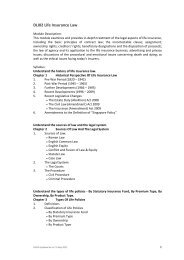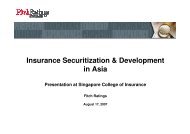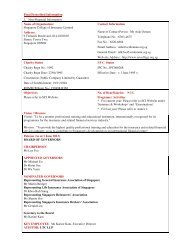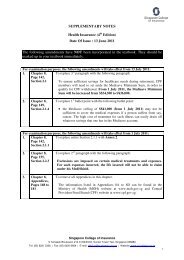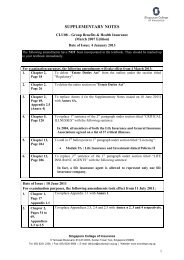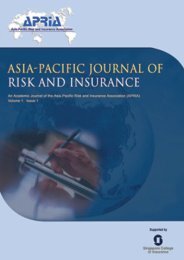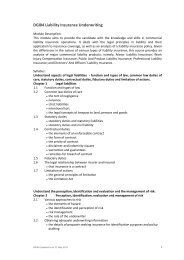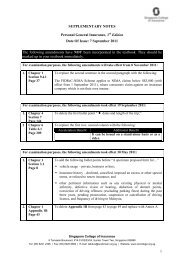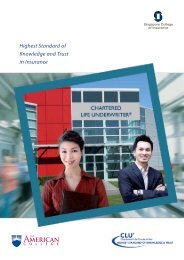Connie Wong (Standard & Poor's) - Singapore College of Insurance
Connie Wong (Standard & Poor's) - Singapore College of Insurance
Connie Wong (Standard & Poor's) - Singapore College of Insurance
You also want an ePaper? Increase the reach of your titles
YUMPU automatically turns print PDFs into web optimized ePapers that Google loves.
“The Role <strong>of</strong> Rating Agencies in<br />
Reinsurance Security Assessment”<br />
CONFIDENTIAL AND PROPRIETARY.<br />
To <strong>Singapore</strong> <strong>College</strong> <strong>of</strong> <strong>Insurance</strong><br />
By <strong>Connie</strong> <strong>Wong</strong>,<br />
Director and Team Leader,<br />
<strong>Insurance</strong> Ratings, Asia<br />
Permission to reprint or distribute any content from this presentation requires the written approval <strong>of</strong> <strong>Standard</strong> & Poor’s.<br />
Copyright (c) 2006 <strong>Standard</strong> & Poor’s, a subsidiary <strong>of</strong> The McGraw-Hill Companies, Inc. All rights reserved.
Agenda<br />
1). Introduction<br />
2.) S&P Rating Methodology and Criteria Update<br />
3.) Regional Outlook for Asian <strong>Insurance</strong> Market<br />
4.) Case Study<br />
4.) Q&A<br />
2.<br />
CONFIDENTIAL AND PROPRIETARY.<br />
August Permission 2005 to reprint or distribute any content from this presentation requires the written approval <strong>of</strong> <strong>Standard</strong> & Poor’s.
Introduction<br />
3.<br />
CONFIDENTIAL AND PROPRIETARY.<br />
August Permission 2005 to reprint or distribute any content from this presentation requires the written approval <strong>of</strong> <strong>Standard</strong> & Poor’s.
<strong>Standard</strong> & Poor’s <strong>Insurance</strong> Ratings<br />
We Currently Rate Approximately 4,000<br />
<strong>Insurance</strong> Companies In Over 70<br />
Countries Across All Sectors Of The<br />
Market<br />
4.<br />
CONFIDENTIAL AND PROPRIETARY.<br />
August Permission 2005 to reprint or distribute any content from this presentation requires the written approval <strong>of</strong> <strong>Standard</strong> & Poor’s.
<strong>Standard</strong> & Poor’s Rating Scale<br />
AAA ‘Exceptionally Strong’<br />
AA ‘Very Strong’<br />
A ‘Strong’<br />
BBB ‘Good’<br />
• ----------------------- Investment grade cut-<strong>of</strong>f<br />
between BBB-Minus and BB- Plus<br />
BB ‘Marginal’<br />
B ‘Weak’<br />
CCC ‘Very Weak’<br />
CC ‘Extremely Weak’<br />
R formally ‘Under Regulatory Supervision’<br />
D ‘In default’<br />
NOTE: Interactive ratings can be further qualified through use <strong>of</strong> ‘+’ and ‘-’ suffixes<br />
There is also a short-term scale: ‘A-1+; ‘A-1’; ‘’A-2’, ‘A-3’, etc.<br />
5.<br />
CONFIDENTIAL AND PROPRIETARY.<br />
August Permission 2005 to reprint or distribute any content from this presentation requires the written approval <strong>of</strong> <strong>Standard</strong> & Poor’s.
Default Rates Over Time by Rating Category<br />
15-yr Average Cumulative Default Rates (%) (1981-<br />
2003)<br />
70<br />
60<br />
50<br />
Default rate<br />
40<br />
30<br />
20<br />
10<br />
0<br />
AAA AA A BBB BB B CCC<br />
<strong>Standard</strong> & <strong>Poor's</strong> Ratings<br />
6.<br />
CONFIDENTIAL AND PROPRIETARY.<br />
August Permission 2005 to reprint or distribute any content from this presentation requires the written approval <strong>of</strong> <strong>Standard</strong> & Poor’s.
Ratings<br />
Insurer Financial Strength Rating (IFSR)<br />
• An Insurer Financial Strength Rating is an current opinion <strong>of</strong> the<br />
financial security characteristics <strong>of</strong> an insurance organization with<br />
respect to its ability to pay under its insurance policies and contracts in<br />
accordance with their terms.<br />
Counterparty Credit Rating (CCR)<br />
• A counterparty credit rating is a current opinion <strong>of</strong> an obligator’s<br />
overall capacity and willingness to meet its financial commitments as<br />
they come due.<br />
7.<br />
CONFIDENTIAL AND PROPRIETARY.<br />
August Permission 2005 to reprint or distribute any content from this presentation requires the written approval <strong>of</strong> <strong>Standard</strong> & Poor’s.
<strong>Standard</strong> & Poor’s Rating Process<br />
Rating request<br />
Pre-meeting<br />
information request<br />
Management<br />
meetings<br />
Rating<br />
committee<br />
8.<br />
CONFIDENTIAL AND PROPRIETARY.<br />
August Permission 2005 to reprint or distribute any content from this presentation requires the written approval <strong>of</strong> <strong>Standard</strong> & Poor’s.
<strong>Insurance</strong> Ratings Methodology and Criteria<br />
9.<br />
CONFIDENTIAL AND PROPRIETARY.<br />
August Permission 2005 to reprint or distribute any content from this presentation requires the written approval <strong>of</strong> <strong>Standard</strong> & Poor’s.
Interactive <strong>Insurance</strong> Ratings Methodology<br />
Major Analytical Categories<br />
• Industry Risks Analysis<br />
• Management and Corporate Strategy<br />
• Competitive Positions<br />
• Operating Performance<br />
• Investments, Asset-Liability Management and<br />
Liquidity<br />
• Capitalization, Reserving & Reinsurance<br />
• Financial Flexibility<br />
CONFIDENTIAL AND PROPRIETARY.<br />
10. August Permission 2005 to reprint or distribute any content from this presentation requires the written approval <strong>of</strong> <strong>Standard</strong> & Poor’s.
<strong>Insurance</strong>/Reinsurance Industry<br />
Retrocession Co.<br />
Flow <strong>of</strong> risks<br />
Reinsurance Co.<br />
ABC <strong>Insurance</strong> Co.<br />
Big <strong>Insurance</strong> Co.<br />
Small <strong>Insurance</strong> Co.<br />
Policyholders<br />
Policyholders<br />
Policyholders<br />
CONFIDENTIAL AND PROPRIETARY.<br />
11. August Permission 2005 to reprint or distribute any content from this presentation requires the written approval <strong>of</strong> <strong>Standard</strong> & Poor’s.
Industry Risks Analysis<br />
Threat <strong>of</strong> New Entrants<br />
Power <strong>of</strong> Suppliers<br />
Competition<br />
Power <strong>of</strong> Buyers<br />
Threat <strong>of</strong> Substitute<br />
Products<br />
CONFIDENTIAL AND PROPRIETARY.<br />
12. August Permission 2005 to reprint or distribute any content from this presentation requires the written approval <strong>of</strong> <strong>Standard</strong> & Poor’s.
Competitive Position<br />
Identifies company’s fundamental characteristics and<br />
source <strong>of</strong> competitive advantage or disadvantage<br />
• Market position<br />
• Product mix<br />
• Distribution system<br />
• Geographic dispersion<br />
• Legal organization chart<br />
CONFIDENTIAL AND PROPRIETARY.<br />
13. August Permission 2005 to reprint or distribute any content from this presentation requires the written approval <strong>of</strong> <strong>Standard</strong> & Poor’s.
Competitive Position – Reinsurance Company<br />
Some questions:<br />
• Size<br />
• National, regional and global players<br />
• Distribution channel – brokers or direct<br />
• Market know how.<br />
• Follower or leader<br />
• Technical expertise<br />
• Risk tolerance, retrocession use<br />
• Short tail or long tail underwriter<br />
• Business portfolio mix<br />
CONFIDENTIAL AND PROPRIETARY.<br />
14. August Permission 2005 to reprint or distribute any content from this presentation requires the written approval <strong>of</strong> <strong>Standard</strong> & Poor’s.
Competitive Advantage<br />
Competitive Advantage<br />
Capital Adequacy<br />
Earnings<br />
CONFIDENTIAL AND PROPRIETARY.<br />
15. August Permission 2005 to reprint or distribute any content from this presentation requires the written approval <strong>of</strong> <strong>Standard</strong> & Poor’s.
Management and Corporate Strategy<br />
• Strategic goals<br />
• Operational skills, planning, controls<br />
• Financial controls, risk tolerance<br />
• Background <strong>of</strong> senior <strong>of</strong>ficers<br />
CONFIDENTIAL AND PROPRIETARY.<br />
16. August Permission 2005 to reprint or distribute any content from this presentation requires the written approval <strong>of</strong> <strong>Standard</strong> & Poor’s.
Operational Performance<br />
• Sources, stability and quality <strong>of</strong> earnings<br />
• Both underwriting and investment<br />
performance<br />
• Measure <strong>of</strong> pr<strong>of</strong>itability<br />
• Review other measures <strong>of</strong> pr<strong>of</strong>itability<br />
• Review tax position<br />
CONFIDENTIAL AND PROPRIETARY.<br />
17. August Permission 2005 to reprint or distribute any content from this presentation requires the written approval <strong>of</strong> <strong>Standard</strong> & Poor’s.
Operational Analysis<br />
Some key ratios:<br />
‣In evaluating underwriting performance<br />
• Premium growth rates<br />
• Nonlife: - expense ratio, loss ratio and<br />
combined ratio,<br />
• Life: - payment ratios, surrender ratios<br />
‣In evaluating investment performance<br />
• Investment yields<br />
‣In evaluating overall performance<br />
• ROA, ROE, Return on revenue<br />
CONFIDENTIAL AND PROPRIETARY.<br />
18. August Permission 2005 to reprint or distribute any content from this presentation requires the written approval <strong>of</strong> <strong>Standard</strong> & Poor’s.
Operational Analysis – Nonlife<br />
‣ Return on revenue (ROR)<br />
Identifies the degree to which the company is able to convert<br />
the insurance business into pr<strong>of</strong>its<br />
‣ Return on equity (ROE)<br />
Identifies the value relative to the invested capital represented<br />
by a company’s pr<strong>of</strong>its – its pr<strong>of</strong>itability<br />
‣ Return on assets (ROA)<br />
Alternative measure <strong>of</strong> pr<strong>of</strong>itability, more useful in comparisons,<br />
especially where A capital gains strategy is employed (use in life<br />
insurance mainly)<br />
CONFIDENTIAL AND PROPRIETARY.<br />
19. August Permission 2005 to reprint or distribute any content from this presentation requires the written approval <strong>of</strong> <strong>Standard</strong> & Poor’s.
<strong>Insurance</strong> Company – Cash Flow<br />
Policyholder<br />
2. Claims<br />
payments<br />
4. Claims<br />
recoveries<br />
Reinsurance<br />
company<br />
1. Premium<br />
income<br />
<strong>Insurance</strong><br />
company<br />
3. Reinsurance<br />
premiums paid<br />
CONFIDENTIAL AND PROPRIETARY.<br />
20. August Permission 2005 to reprint or distribute any content from this presentation requires the written approval <strong>of</strong> <strong>Standard</strong> & Poor’s.
Investment<br />
Factors we need to look at:<br />
• Investment strategies<br />
• Investment portfolio mix<br />
• Liquidity<br />
• Assets quality<br />
• Interest rate risks<br />
• Market risks<br />
• Asset and liability management<br />
• Investment performance<br />
CONFIDENTIAL AND PROPRIETARY.<br />
21. August Permission 2005 to reprint or distribute any content from this presentation requires the written approval <strong>of</strong> <strong>Standard</strong> & Poor’s.
Capitalization - Determinants<br />
• Capital management and policy<br />
• Capital quality<br />
• Capital adequacy model – risk based<br />
• Reserves<br />
• Reinsurance credit risks<br />
• Debts and hybrid used<br />
• Financial leverage<br />
• Contingent liability and guarantee<br />
• Other threats to capital<br />
CONFIDENTIAL AND PROPRIETARY.<br />
22. August Permission 2005 to reprint or distribute any content from this presentation requires the written approval <strong>of</strong> <strong>Standard</strong> & Poor’s.
Capitalization –proxy ratio<br />
Proxy ratio for P&C insurance company:<br />
‣Nonlife:<br />
Shareholders’ funds<br />
Net Premium Income<br />
CONFIDENTIAL AND PROPRIETARY.<br />
23. August Permission 2005 to reprint or distribute any content from this presentation requires the written approval <strong>of</strong> <strong>Standard</strong> & Poor’s.
Risk Base Capital Assessment<br />
For nonlife insurance company:<br />
Total adjusted<br />
capital TAC -<br />
Asset related<br />
risks (C1)<br />
-<br />
Pricing risks<br />
risks (C2)<br />
Premium risks<br />
(C3)<br />
Reserving risks<br />
+ (C4)<br />
+<br />
Other<br />
business risks<br />
(C5)<br />
TAC – total adjusted capital<br />
CONFIDENTIAL AND PROPRIETARY.<br />
24. August Permission 2005 to reprint or distribute any content from this presentation requires the written approval <strong>of</strong> <strong>Standard</strong> & Poor’s.
Assessment Of Capital Adequacy<br />
Capital Adequacy Ratio<br />
175% and above<br />
150% - 174%<br />
125% - 149%<br />
100% - 124%<br />
Below 100%<br />
Assessment <strong>of</strong> Capital<br />
Adequacy<br />
Extremely Strong<br />
Very Strong<br />
Strong<br />
Good<br />
Marginal<br />
CONFIDENTIAL AND PROPRIETARY.<br />
25. August Permission 2005 to reprint or distribute any content from this presentation requires the written approval <strong>of</strong> <strong>Standard</strong> & Poor’s.
Reserving : Key Points<br />
Analysis encompasses<br />
• Company methodology<br />
and assumptions<br />
• Historic claims<br />
development ratios<br />
• Company systems and<br />
processes<br />
• Company reserve review<br />
procedures<br />
• Present and future<br />
expected claims trends<br />
CONFIDENTIAL AND PROPRIETARY.<br />
All analysis by class <strong>of</strong><br />
business<br />
• Looking for historic and<br />
potential future trends <strong>of</strong><br />
redundancy or deficiency<br />
• Case estimates – reported<br />
claims<br />
• Incurred But Not Reported<br />
(IBNR)<br />
• Incurred But Not Enough<br />
Reported (IBNER)<br />
• Inflation/Discount Rates<br />
used<br />
• Basis for superimposed<br />
inflation<br />
26. August Permission 2005 to reprint or distribute any content from this presentation requires the written approval <strong>of</strong> <strong>Standard</strong> & Poor’s.
Financial Flexibility<br />
• Available sources <strong>of</strong> new capital<br />
• Anticipated cash requirements<br />
• Shareholder dividend policy<br />
• Accessibility to reinsurance markets<br />
• Impact <strong>of</strong> non-insurance activities<br />
CONFIDENTIAL AND PROPRIETARY.<br />
27. August Permission 2005 to reprint or distribute any content from this presentation requires the written approval <strong>of</strong> <strong>Standard</strong> & Poor’s.
Our Recent Major Updated Criteria Initiatives<br />
Initiatives<br />
Changes/Update<br />
Enterprise Risk Management<br />
(ERM)<br />
Updating Capital Model<br />
To enhance processes by<br />
increasing our analytical focus<br />
on insurers’ risk management<br />
practices<br />
From existing risk base capital<br />
model to “target capital” based<br />
on insurers’ risk pr<strong>of</strong>ile<br />
CONFIDENTIAL AND PROPRIETARY.<br />
28. August Permission 2005 to reprint or distribute any content from this presentation requires the written approval <strong>of</strong> <strong>Standard</strong> & Poor’s.
ERM Evaluation Components<br />
Strategic Risk Management<br />
Risk<br />
Control<br />
Processes<br />
Emerging<br />
Risks<br />
Mgmt<br />
Risk &<br />
Economic<br />
Capital<br />
Models<br />
Risk Management Culture<br />
CONFIDENTIAL AND PROPRIETARY.<br />
29. August Permission 2005 to reprint or distribute any content from this presentation requires the written approval <strong>of</strong> <strong>Standard</strong> & Poor’s.
ERM Evaluation on 241 <strong>Insurance</strong> Entities – 2006<br />
Weak<br />
5%<br />
Excellent<br />
3%<br />
Strong<br />
10%<br />
Adequate<br />
82%<br />
CONFIDENTIAL AND PROPRIETARY.<br />
30. August Permission 2005 to reprint or distribute any content from this presentation requires the written approval <strong>of</strong> <strong>Standard</strong> & Poor’s.
Regional Outlook for Asian <strong>Insurance</strong> Market<br />
CONFIDENTIAL AND PROPRIETARY.<br />
31. August Permission 2005 to reprint or distribute any content from this presentation requires the written approval <strong>of</strong> <strong>Standard</strong> & Poor’s.
Asia-Pacific Region Life <strong>Insurance</strong> Trends<br />
Outlook: Stable<br />
• Supported by more favorable operating environment<br />
• Expect favorable operating performance<br />
• Strengthened balance sheet<br />
• Good mortality experience<br />
• Main growth driver: wealth management type products<br />
• Growing markets<br />
Some Challenges:<br />
• Top line growth volatility<br />
• Negative spreads burden in some life insurance markets<br />
• Enhancement <strong>of</strong> asset and liabilities management<br />
• Limited capital sources for rapid growing markets<br />
CONFIDENTIAL AND PROPRIETARY.<br />
32. August Permission 2005 to reprint or distribute any content from this presentation requires the written approval <strong>of</strong> <strong>Standard</strong> & Poor’s.
Asia-Pacific Region NonLife <strong>Insurance</strong> Trends<br />
Outlook: Stable<br />
• Supportive operating performance although lowered underwriting pr<strong>of</strong>it<br />
• Strengthened balance sheet<br />
• Strong potential market growth<br />
• Increased reinsurance support<br />
Some Challenges<br />
• Heightening competition<br />
• Weak market discipline in some markets<br />
• Need more advance technical know-how in some markets<br />
• Less stringent reserving practices in some markets<br />
• Changing claims pattern, especially in some developing markets<br />
• Limited capital sources for rapid growing markets<br />
CONFIDENTIAL AND PROPRIETARY.<br />
33. August Permission 2005 to reprint or distribute any content from this presentation requires the written approval <strong>of</strong> <strong>Standard</strong> & Poor’s.
Other Issues<br />
• Greater delineation between successful and<br />
marginal players<br />
• Heightening regulatory control<br />
• Consolidation, mergers and acquisitions are traced<br />
• Opening <strong>of</strong> markets - foreign participation<br />
• Capital management<br />
• Shallow investment markets<br />
CONFIDENTIAL AND PROPRIETARY.<br />
34. August Permission 2005 to reprint or distribute any content from this presentation requires the written approval <strong>of</strong> <strong>Standard</strong> & Poor’s.
Economic and Industry Risk<br />
Asia Pacific Life <strong>Insurance</strong> Markets<br />
Economic Risk<br />
Very high<br />
High<br />
Moderately<br />
Moderate<br />
Moderately low<br />
Low<br />
high<br />
Low<br />
Moderately<br />
Australia<br />
Industry Risk<br />
low<br />
Moderate<br />
Moderately<br />
China<br />
Thailand<br />
Malaysia<br />
Taiwan<br />
<strong>Singapore</strong><br />
Hong Kong<br />
Japan<br />
New Zealand<br />
high<br />
High<br />
India<br />
Philippines<br />
Very high<br />
Indonesia<br />
Vietnam<br />
CONFIDENTIAL AND PROPRIETARY.<br />
35. August Permission 2005 to reprint or distribute any content from this presentation requires the written approval <strong>of</strong> <strong>Standard</strong> & Poor’s.
Economic and Industry Risk in<br />
Asia Pacific Nonlife <strong>Insurance</strong> Markets<br />
Economic Risk<br />
Very high<br />
High<br />
Moderatel<br />
y high<br />
Moderate<br />
Moderately low<br />
Low<br />
Low<br />
Industry Risk<br />
Moderately<br />
low<br />
Moderate<br />
Moderately<br />
high<br />
China<br />
Thailand<br />
Korea<br />
Taiwan<br />
Malaysia<br />
Australia<br />
Japan<br />
New Zealand<br />
Hong Kong<br />
<strong>Singapore</strong><br />
High<br />
India<br />
Philippines<br />
Very high<br />
Indonesia<br />
Vietnam<br />
CONFIDENTIAL AND PROPRIETARY.<br />
36. August Permission 2005 to reprint or distribute any content from this presentation requires the written approval <strong>of</strong> <strong>Standard</strong> & Poor’s.
Outlook in the Asia Pacific Region<br />
Stable outlook:<br />
• Life and nonlife insurance markets <strong>of</strong> Australia, Japan, Hong Kong,<br />
<strong>Singapore</strong>, India, Malaysia, Thailand, Philippines and<br />
• nonlife insurance market <strong>of</strong> New Zealand<br />
Positive outlook:<br />
• Life and nonlife insurance market <strong>of</strong> China<br />
CONFIDENTIAL AND PROPRIETARY.<br />
37. August Permission 2005 to reprint or distribute any content from this presentation requires the written approval <strong>of</strong> <strong>Standard</strong> & Poor’s.
Case Study<br />
CONFIDENTIAL AND PROPRIETARY.<br />
38. August Permission 2005 to reprint or distribute any content from this presentation requires the written approval <strong>of</strong> <strong>Standard</strong> & Poor’s.
Case Study – Central Reinsurance Corporation<br />
Background<br />
• As one <strong>of</strong> the major reinsurers operating in Taiwan,<br />
Central Re has built up strong long-term relationships<br />
with domestic insurers.<br />
• The company's gross premiums amounted to about<br />
NT$18.9 billion in 2005, with 79% from property and<br />
casualty reinsurance and 21% from life reinsurance.<br />
• Mirroring the growth <strong>of</strong> the domestic insurance market,<br />
annualized growth <strong>of</strong> gross premiums was about 2% in<br />
the first half <strong>of</strong> 2006 and 12% in 2005.<br />
CONFIDENTIAL AND PROPRIETARY.<br />
39. August Permission 2005 to reprint or distribute any content from this presentation requires the written approval <strong>of</strong> <strong>Standard</strong> & Poor’s.
Case Study – Central Reinsurance Corporation<br />
Background<br />
• Central Re mainly writes proportional reinsurance, and its<br />
risk pr<strong>of</strong>ile is relatively short tail in comparison with that <strong>of</strong><br />
international reinsurers. In 2005, about 90% <strong>of</strong> the<br />
company's total business consisted <strong>of</strong> proportional<br />
treaties, while about 96% <strong>of</strong> the total business was<br />
sourced in Taiwan.<br />
• Central Re has a diverse premium mix. Of total gross<br />
premiums written in the first half <strong>of</strong> 2006, motor<br />
accounted for 40%, followed by compulsory earthquake<br />
(10%), life insurance (10%), fire (9%), marine (6%),<br />
casualty insurance (6%), health insurance (6%),<br />
engineering (1%), and others (12%).<br />
CONFIDENTIAL AND PROPRIETARY.<br />
40. August Permission 2005 to reprint or distribute any content from this presentation requires the written approval <strong>of</strong> <strong>Standard</strong> & Poor’s.
Case Study – Central Reinsurance Corporation<br />
Selected Statistics<br />
Total assets (Mil. US$)<br />
Total assets (Mil. NT$)<br />
Equity (Mil. NT$)<br />
Net pr<strong>of</strong>it after tax (Mil. NT$)<br />
--Year-ended Dec. 31--<br />
2006* 2005 2004 2003 2002<br />
713 690 610 565 490<br />
23,538 22,782 20,137 18,655 16,157<br />
6,381 6,568 5,288 4,493 3,744<br />
281 647 399 359 309<br />
Business Statistics<br />
Gross premiums written (Mil. 9,648 18,936 16,861 17,191 15,877<br />
NT$)<br />
Gross premiums written<br />
1.9 12.3 -1.92 8.3 10.2<br />
growth per annum (%)<br />
Business mix--gross premiums written:<br />
Domestic (%) N.A. 96.5 98.2 N.A. N.A.<br />
International<br />
N.A. 3.5 1.8 N.A. N.A.<br />
(%)<br />
Total (%) N.A. 100 100 N.A. N.A.<br />
Operating Statistics<br />
Net premium income (Mil.<br />
NT$)<br />
Earned premium income (Mil.<br />
NT$)<br />
Underwriting pr<strong>of</strong>it (Mil. NT$)<br />
Return on revenue (%)<br />
Investment yield excluding<br />
capital gains (%)<br />
Investment return including<br />
capital gains (%)<br />
Loss ratio (%)<br />
Expense ratio (%)<br />
Combined ratio (%)<br />
6,492 12,591 11,468 11,580 10,737<br />
6,466 12,153 11,574 11,370 10,524<br />
131 347 406 319 235<br />
6.8 8.5 6.9 6.5 6<br />
2.6 2.3 2.2 2.2 2.6<br />
2.9 3.5 2.2 2.6 2.7<br />
64.9 64.2 63.6 63.2 66.6<br />
33 31.8 33.2 33.4 30.5<br />
97.8 96 96.8 96.6 97.2<br />
CONFIDENTIAL AND PROPRIETARY.<br />
41. August Permission 2005 to reprint or distribute any content from this presentation requires the written approval <strong>of</strong> <strong>Standard</strong> & Poor’s.
Case Study – Central Reinsurance Corporation<br />
Investment Statistics<br />
Total investment assets (Mil.<br />
NT$)<br />
Investment composition:<br />
21,008 20,501 18,547 16,758 14,165<br />
Deposits (%) 27.9 31.5 30.5 23.1 46.5<br />
Public<br />
0.7 1.2 3.5 8.5 11.3<br />
securities (%)<br />
Debentures/n<br />
31.9 50.7 51.9 52.2 31<br />
otes (%)<br />
Shares (%) 11.2 7.6 6.6 7.5 3.6<br />
Loans (%) 0 0 0 0 0<br />
Property (%) 2.2 2.3 2.5 2.8 2.6<br />
Other (%) 26.1 6.7 5 6 5<br />
Total (%) 100 100 100 100 100<br />
Capitalization Statistics<br />
Equity (Mil. NT$)<br />
Special reserves (Mil. NT$)<br />
Equity/net premium income<br />
(%)<br />
Equity/net outstanding claims<br />
(%)<br />
Equity/assets (%)<br />
6,381 6,568 5,288 4,493 3,744<br />
2,931 2,829 2,518 2,220 1,928<br />
98.3 52.2 46.1 38.8 34.9<br />
103.5 112.9 98.5 93.6 90.6<br />
27.1 28.8 26.3 24.1 23.2<br />
*Six months ended June 30. Note: Equity excludes special reserves. Pretax and aftertax income include<br />
changes in special reserves.<br />
CONFIDENTIAL AND PROPRIETARY.<br />
42. August Permission 2005 to reprint or distribute any content from this presentation requires the written approval <strong>of</strong> <strong>Standard</strong> & Poor’s.
Case Study – Central Reinsurance Corporation<br />
Rating committee:<br />
1. Group into 5 teams<br />
2. Study the information and fill in the rating analysis<br />
score sheet (15 mins)<br />
3. Please discuss with team members on their<br />
business and financial pr<strong>of</strong>ile and make the<br />
recommendation on rating (15 mins)<br />
4. Vote for the recommended rating<br />
5. Rating outcome and rationales<br />
CONFIDENTIAL AND PROPRIETARY.<br />
43. August Permission 2005 to reprint or distribute any content from this presentation requires the written approval <strong>of</strong> <strong>Standard</strong> & Poor’s.
Contact for <strong>Insurance</strong> Ratings<br />
Key Analytical Contact for <strong>Insurance</strong> Companies in Asia Pacific<br />
Ms. <strong>Connie</strong> <strong>Wong</strong>, Director & Team Leader, <strong>Insurance</strong> Ratings, Asia excl JP/KR<br />
Tel: 852-2533-3553; connie_wong@standardandpoors.com<br />
Mr. Paul Clarkson, Associate Director, <strong>Insurance</strong> Ratings, Asia excl JP/KR<br />
Tel: 852-2533-3594; paul_clarkson@standardandpoors.com<br />
Ms. Eunice Tan, Ratings Specialist, <strong>Insurance</strong> Ratings, Asia excl JP/KR<br />
Tel: 65-6239-6343; eunice_tan@standardandpoors.com<br />
Mr. Tatsuo Kurogi, Director, <strong>Insurance</strong> Ratings, Japan<br />
Tel: 81-3-4550-8329; tatsuo_kurogi@standardandpoors.com<br />
Ms. YuMee Oh, Ratings Specialist, Korea (based in Tokyo)<br />
Tel: 813-4550-8413; yumee_oh@standardandpoors.com<br />
Mr. Michael Vine, Director & Team Leader, <strong>Insurance</strong> Ratings, AU/NZ<br />
Tel: 61-3-9631-2102; michael_vine@standardandpoors.com<br />
Customer Relationship Contact<br />
Mr. Rocco Sta.Maria, Managing Director & Head <strong>of</strong> Client Services and Sales Asia<br />
Tel: 65-6239-6338; Rocco_StaMaria@standardandpoors.com<br />
CONFIDENTIAL AND PROPRIETARY.<br />
44. August Permission 2005 to reprint or distribute any content from this presentation requires the written approval <strong>of</strong> <strong>Standard</strong> & Poor’s.
www.standardandpoors.com<br />
Analytic services and products provided by <strong>Standard</strong> & Poor’s are the result <strong>of</strong> separate activities designed to preserve the independence and objectivity<br />
<strong>of</strong> each analytic process. <strong>Standard</strong> & Poor’s has established policies and procedures to maintain the confidentiality <strong>of</strong> non-public information received<br />
CONFIDENTIAL AND PROPRIETARY.<br />
during each analytic process.<br />
45. August Permission 2005 to reprint or distribute any content from this presentation requires the written approval <strong>of</strong> <strong>Standard</strong> & Poor’s.


